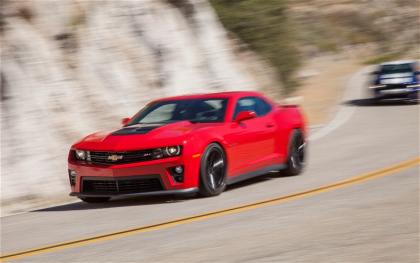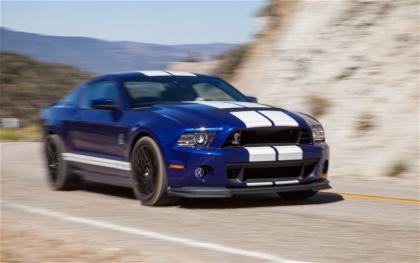2012 Chevrolet Camaro ZL1 vs. 2013 Ford Shelby GT500

MORE AT MOTORTREND.COM
Mustang and Camaro. These two flag-waving, tire-shredding, all-American musclecars have met countless times on the street, the strip, the track, the newsstand, and the Internet over the past four and a half decades. Enthusiasts willing, they'll continue to do battle for decades to come. For the moment, though, it comes down to this.
We recently set out to determine which of these two titans -- arguably the greatest cars of their lineage -- is the better car. We took the 2012 Chevrolet Camaro ZL1 and the 2013 Ford Shelby GT500 to the street, the dragstrip, and the racetrack. In each venue, the two heavyweights squared off, and where each corner may have expected a knockout, we were treated to a true competition far closer than we expected.
Knowing full well that we're about to anger at least half of you, let's step into the ring.
THE STREET

No matter how many of you out there regularly drag or track your car, the majority of your miles are covered on the street. It's an unforgiving place, full of bad pavement, bad drivers, and endless traffic. It offers little to no objective, scientific data about how a car performs, but rather a feeling, a subjective impression. At the end of a long day of driving, we had to ask ourselves which one we'd rather drive the next day.
It's hard to believe, but these two cars and their combined 1242 horsepower and 1187 lb-ft of torque are incredibly easy to drive to work. Both offer progressive clutch engagement and easily modulated throttles. Both feature electronically adjustable shock absorbers to improve ride quality, and big brakes that never come off grabby. Both are not, however, equal.
Be it a back road or the daily commute, the Camaro ZL1 is the better street car. Its magnetorheological shock absorbers offer an impressive performance range, smoothing the impacts of rough pavement in Tour mode and keeping the heavy chassis under control in Sport mode. Senior features editor Jonny Lieberman described it to me as "basically a sportier CTS-V," balancing ride and handling beautifully. The GT500, by contrast, suffers from a stiffer ride and too much vertical motion. Every bump gets your head bobbing up and down as the big Shelby bucks like an unbroken colt. Its two-mode Bilstein shocks are simply too stiff for everyday driving, even in Normal mode.
The GT500 just isn't meant for everyday driving. It's built for performance, so we got off the freeways and surface streets and headed for the hills. One of two things happens on a canyon road: either a car comes into its element and digs in, delivering a fantastic driving experience, or all the problems you noticed on the way out of town are amplified. The GT500 does both. On the one hand, it handles better than any solid axle car -- save perhaps the Boss 302 -- has any right to, but on the other, that vertical motion grates on your confidence. Real-world roads aren't racetrack-smooth. They have bumps in inconvenient places, such as mid-corner overlooking a gorge.
To be clear, the Mustang never tried to get away from us, but there was always a niggling suspicion it might. Hit a bump under any condition, be it acceleration, cornering, or braking, and that live rear axle begins dancing around, undermining driver confidence and slowing you down. We also noticed the brakes lose some of their initial bite as they heated up, a problem that later came back to haunt the Shelby.
The ZL1, by virtue of its independent suspension and magnetic shocks, did not suffer this problem. Rather, it was planted and confident, never dancing over the bumps or otherwise testing the driver's resolve. Whereas the GT500 was work to drive hard, the Camaro made you feel like a hero, encouraging you to push ever harder. Drivers of both cars will have fun, but the ZL1 driver won't be sweating at the end of the road.

That's not to say the GT500 is no fun. In fact, the Shelby offers better steering than the Camaro, with sharper turn-in and better feel. It also provides better sight lines as a result of its high seating position, which leaves you feeling like you're riding on top of the car rather than in it. While the Camaro feels more like a sports car, its massive pillars and small windows impede outward visibility.
Perhaps the most telling difference came in how the cars used their potentially unwieldy power. Both cars wear Goodyear Eagle F1 Supercar G:2 tires, though the Camaro's are wider front and rear. This tire, as we've seen many times, absolutely needs heat to work. When it gets cold, it's rock hard and has little grip. Get it heated up, though, and it sticks like glue. I mention this because the cars behaved very differently on cold tires. The Shelby constantly was chirping and spinning the tires and sliding the back end around, even with stability and traction control on. The ZL1 did nothing of the sort. With both cars making far more than enough torque to obliterate the rear tires at 1500 RPM, credit goes to the Camaro's suspension for keeping the power on the ground, in spite of the tires.
At the end of our road loops, the response from the editors was consistent. The Mustang was simply harder to drive fast. Some preferred the challenge instead of the Camaro's reflexive, unflappable handling, but unless you're our esteemed road test editor or a professional racer, you'll be faster and more confident behind the wheel of the Camaro.
THE STRIP
Drag racing and musclecars go hand-in-hand. From a stoplight or a Christmas tree, there's no rush like a wide-open throttle blast through the gears, and anyone can do it. Anyone with the desire to buy a factory supercharged V-8 certainly will. We did, over and over.
Drag racing, though, is not as cut-and-dry as it sounds. Timing is vitally important, as is traction. Cut a bad 60-foot time, and you might as well abort the race and try again. Still, it's usually a fair bet that all other things being equal, the more powerful car will win. That's certainly the case here. The 662-horsepower GT500 hits 60 mph in 3.5 seconds to the 580-horsepower ZL1's 3.8 seconds. The gap only widens from there, with the GT500 finishing the quarter-mile in 11.6 seconds at a blazing 125.7 mph, trailed by the Camaro at 12.1 seconds and 117.4 mph.
It's a closer race than it sounds like. Both cars feature launch control, so all you have to do is floor the gas and release the clutch (don't side-step it) and you'll lay down a consistent time, one even an experienced drag racer would have trouble beating. That's because both cars will be spinning their tires and wagging their tails all the way through first gear, launch control computers be damned. When you're putting that much torque to just two tires, these things happen. The Mustang and its extra 75 lb-ft of torque suffer more here, with more wheel spin and more sliding around. As a result, the race is actually very close through the first two gears until the Mustang finally hooks up and walks away in third.
Despite its better times, the Mustang is more work to drive fast. But to quote everyone's favorite drag racing movie, "winning's winning." With Ford's adjustable launch control, even a novice drag racer will be able to put away ZL1s at the drag strip behind the wheel of a GT500.

 Yahoo Autos
Yahoo Autos 
